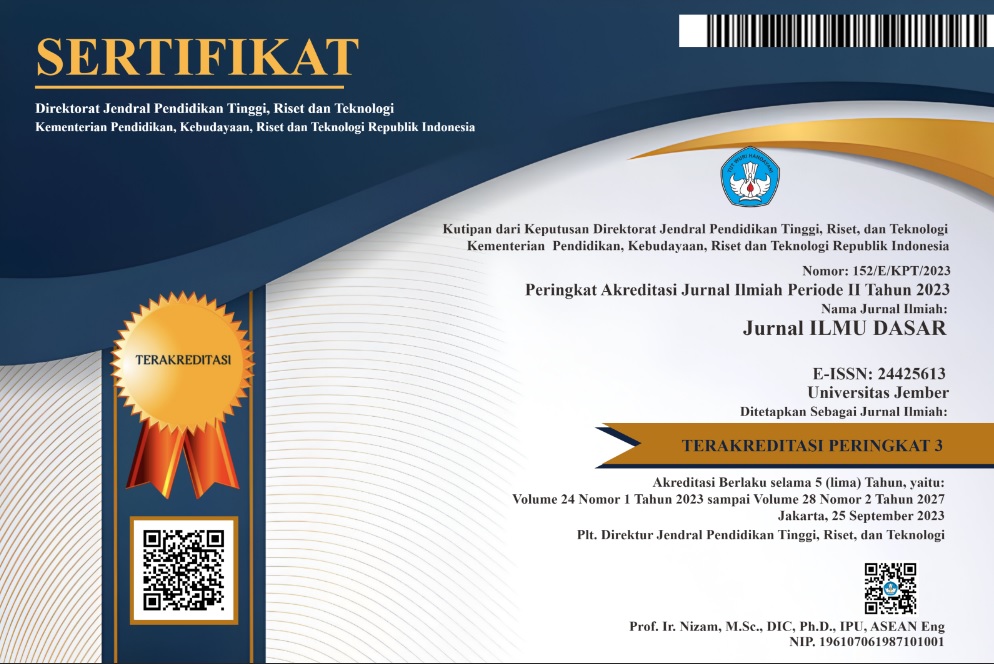The Binding Prediction of 6-Paradol and its Derivatives on TRPV1 Agonist as a New Compound for Treating Painful Diabetic Neuropathy
DOI:
https://doi.org/10.19184/jid.v23i2.23030Keywords:
ginger, 6-paradol, painful diabetic neuropathy, trpv1Abstract
Ginger was reported to have a suppressive effect on pain in patients with Painful Diabetic Neuropathy (PDN). Our latest study revealed that 6-shogaol, one of the ginger components, had the best affinity in the Transient Receptor Potential Vanilloid 1 (TRPV1), a key receptor in PDN). Paradol, which obtained from gingerol and shogaol metabolism, also had potent activities in several diseases, compared to the other derivatives of gingerol and shogaol. However, shogaol and paradol is very similar in chemical structure with only different in one double bond in 4-5 position. Until now there is no explanation about paradol mechanism in TRPV1. Based on this, our study was designed to predict the activity of 6-paradol and its derivatives to TRPV1 as target receptor in PDN using in-silico model. 2-paradol, 4-paradol, 6-paradol, 8-paradol and 10-paradol were used as ligands. Capsaisin, the agonist of TRPV1, was used as a native ligand in this study. TRPV1 was obtained from protein data bank (PDB). Ligand bond prediction and affinity was performed using Molegro Virtual Docker. The results showed 2-paradol, 4-paradol, 6-paradol, 8-paradol and 10-paradol had good affinity against TRPV1. These result indicated that 6-paradol and the derivatives had potential as a drug compound for PDN therapy.
Downloads
References
Bhal, SK. 2019. Application Note Lipophilicity Descriptors : Understanding When to Use Log P & Log D Application of Lipophilicity Descriptors in Drug. Adv. Chem. Dev. 3-6.
Black CD, Herring MP, Hurley D & O’Connor PJ. 2010. Ginger (Zingiber officinale) Reduces Muscle Pain Caused by Eccentric Exercise. J. Pain. 11(9): 894-903.
Fajrin FA, Nugroho AE, Nurrochmad A & Susilowati R. 2018. Molecular Docking Analysis of Ginger Active Compound on Transient Receptor Potential Cation Channel Subfamily V Member 1 (TRPV1). Indones. J. Chem. 18(1): 179-185.
Gaire BP, Kwon OW, Park SH, Chun K-H, Kim SY, Shin DY & Choi JW. 2015. Neuroprotective Effect of 6-Paradol in Focal Cerebral Ischemia Involves The Attenuation of Neuroinflammatory Responses in Activated Microglia. Plos One. 10(3): 1-17.
Gram, Dorte X, Hansen, Anker J, Deacon, Carolyn F, Brand, Christian L, Ribel, Ulla, Wilken, Michael, Carr, Richard D, Svendsen, Ove & Ahrén Bo. 2005. Sensory Nerve Desensitization by Resiniferatoxin Improves Glucose Tolerance and Increases Insulin Secretion in Zucker Diabetic Fatty Rats and Is Associated with Reduced Plasma Activity of Dipeptidyl Peptidase IV. Eur. J. Pharmacol. 509(2-3): 211-217.
Haghighi M, Khalvat A, Toliat T & Jallaei S. 2005. Comparing The Effects of Ginger (Zingiber officinale) Extract And Ibuprofen On Patients With Osteoarthritis.Arch Iran. Med. 8(4): 267-271.
Hutapea FS, Kembuan, Mieke AHN & Maja PSJ. 2016. Gambaran Klinis Neuropati Pada Pasien Diabetes Melitus di Poliklinik Neurologi RSUP Prof. Dr. R. D. Kandou Periode Juli 2014 - Juni 2015. e-Clinic. 4(1).
Jo SK, Kim IS, Rehman SU, Ha SK, Park HY, Park YK & Yoo HH. 2016. Characterization of Metabolites Produced From The Biotransformation of 6-Shogaol Formed by Aspergillus niger. Eur. Food Res. Technol. 242(1): 137-142.
Kano M, Ohno-Shosaku T, Hashimotodani Y, Uchigashima M & Watanabe M. 2009. Endocannabinoid-mediated Control of Synaptic Transmission. Physiol. Rev. 89(1): 309-380.
Keum YS, Kim J, Lee KH, Park KK, Surh YJ, Lee JM, Lee SS, Yoon JH, Joo SY, Cha IH, Yook JI. 2002. Induction of Apoptosis and Caspase-3 Activation by Chemopreventive [6]-Paradol and Structurally Related Compounds in KB Cells. Cancer Lett. 177(1): 41-47.
MantiriN.C., AwaloeiH., and PosangiJ. 2013. Perbandingan Efek Analgesik Perasan Rimpang Jahe Merah (Zingiber officinale var. rubrum Thelaide) dengan Aspirin Dosis Terapi Pada Mencit (Mus musculus. J. e-Biomedik. 1(1): 518–523.
Nurtjahja-Tjendraputra E, Ammit AJ, Roufogalis BD, Tran VH & Duke CC. 2003. Effective Anti-platelet and COX-1 Enzyme Inhibitors From Pungent Constituents of Ginger. Thromb. Res. 111(4-5): 259-265.
PabbidiR M, YuS Q, Peng S, Khardori R, Pauza ME & Premkumar LS. 2008. Influence of TRPV1 on Diabetes-Induced Alterations in Thermal Pain Sensitivity. Mol. Pain. 4: 1-17.
Puspaningtyas AR. 2012. Molekular Docking dengan Metode Molegro Virtual Docker Turunan Kalkon sebagai Antimikroba. Stomatognatic. 9(1): 39-47.
Smith HS & Argoff CE. 2013. Pharmacological Treatment Of Neuropathic Pain. Pain Int. Res. Pain Manag. 71(5): 203-226.
Su K, Wook D, Soo Y, Seop M, Park S, Choi S, Pearce LV, Blumberg PM & Lee J. 2011. Bioorganic & Medicinal Chemistry Letters Receptor Activity and Conformational Analysis of 5 0 -halogenated Resiniferatoxin Analogs as TRPV1 Ligands. Bioorg. Med. Chem. Lett. 21(1): 299-302.
Suhud F. 2015. Uji aktivitas in-silico senyawa baru 1-benzil-3-benzoilurea induk dan tersubstitusi sebagai agen antiproliferatif. Jurnal Farmasi Indonesia. B(4):242-251.
Suri A & Szallasi A.2008. The Emerging Role of TRPV1 in Diabetes and Obesity. Trends Pharmacol. Sci. 29(1): 29-36.
Wahyuliati T. 2006. Antidepresan pada Nyeri Neuropati Diabetik. Mutiara Medika. 6(1): 33-41.
Wei CK, Tsai YH, Korinek M, Hung PH, El-Shazly M, Cheng YB, Wu YC, Hsieh TJ, Chang FR. 2017. 6-Paradol and 6-Shogaol, the Pungent Compounds of Ginger, Promote Glucose Utilization in Adipocytes and Myotubes, and 6-Paradol Reduces Blood Glucose in High-Fat Diet-Fed Mice. Int. J. Mol. Sci. 18(1): 1-18.








